This document is an extract from a technical report by Domenico Ricciardi, a Masters
student at CEFRIEL, the Center of Excellence For Research, Innovation, Education
and Industrial Labs at the Polytechnic of Milan, in collaboration with Alcatel.
For further information, please contact
CEFRIEL.
1 Report summary
In the past the attention of the telecommunications planners was addressed essentially
to the technical specification of the project, having to answer to the always increasing
requirements in terms of high bit rate data transmission, consequently to the increasing
demand of multimedia and on-demand services with high Quality of Service (QoS) both
in the field of the fixed and mobile communications.
A new trend is now emerging: users and their needs must be the hub for the definition
of network technical specifications, for the selection of the most suitable technology,
and for the implementation of applications and services. Equipment and proposed
solutions must be driven by economical factors. This is the area covered by this
document.
The objective of the study was to define a business model to analyze broadband access
technologies from a managerial point of view. The analysis deals with “national
level modeling”, considering different technologies in order to compare relevant
solutions. STEM models were created to analyze the access technologies ADSL, Gigabit
Ethernet, UMTS, WiFi, WiMax and the main services offered thought them. Main outputs
driving conclusions will be, for each market segment, bandwidth and connection requirements
for each service and the number of installed units for each resource. Global outputs
considered will be the network NPV and the operating charge, with details for individual
resources.
2 The main business model
2.1 Full view (Market segment - Services - Resources - Deployment)
The figure below shows the basic structure of the main model developed. It is easy
to identify within this view the market segments, the offered services, and the
resources necessary to satisfy the demand both in term of connection and bandwidth.
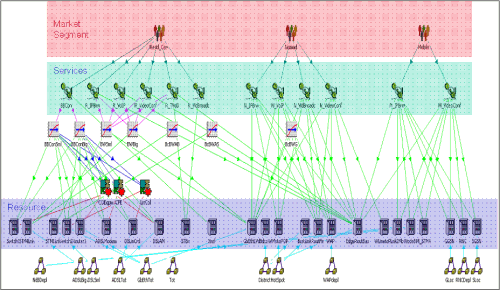
The Business Model: Full View
The objective of the model is the analysis of a solution that offers broadband services
to three market segments:
- Residential: all of the homes in Italy.
- Nomadic: all the individuals who own a Laptop or a PDA.
- Mobile: all Italian citizens owning a mobile phone or terminal.
We propose to serve the Residential market segment with ADSL or Gigabit Ethernet
access technologies, Nomadic with WiMax or fiber access and Mobile with UMTS. As
shown in the second level of the figure above, we provide the following services
to these three market segments:
- IP Browsing: a collection of services that will include always-on email and web
browsing, on-line gaming, and remote LAN access.
- Videoconference: is the service that allows individuals or groups to meet face-to-face
in real time and to interact.
- Video-on-demand (VoD): a service by which viewers can watch video programs on their
own television sets at the time they choose.
- Video Broadcast: With this service, a subscriber can receive, in digital format,
the main terrestrial and satellite TV channels.
Not all the services are addressed to every market segment. In the following table
we show what market segments will be addressed by which services:

Services for each market segment
The third level of the figure represent the resources necessary to satisfy the demand
coming from the services both in term of bandwidth requirement and in term of connections.
The lowest level of the view contains icons that represent the Locations. These
drive the resources deployed to achieve the planned geographical coverage. The covered
population is a function of the deployment strategy better explained in the residential
market evaluation (see below).
2.2 Traffic and resource demand
The criteria used to derive resource demand from traffic volume are applied to all
market segments and can be explained here for the whole model.
Deterministic traffic capacity-based dimensioning.

Statistical dimensioning
(a) Data type traffic

where:

Based on Erlang-C with Max queue=60 average buffer size; GoS (overflow probability) <10-8
we have derived Loading Factor=0.7 as a conservative parameter in our range of application.
(b) Circuit type traffic
For circuit-like traffic (Voice, Videoconference and VoD) asking for dedicated circuits,
within the model we have used Erlang B formula to evaluate the "worst case" situation.
To guarantee the expected performance on all nodes of the network we define the
GoS as a function of the incoming traffic, assuming the following linearization.

Our choice comes from an Excel calculation that leads to the figures below.
Voice and Videoconference:
Reserved Circuit=8; Loading Factor=0.9 (to keep GoS<1%)

Evaluation of reserved circuits for videoconference and voice services
Video on Demand:
Reserved circuit=6; Loading Factor=0.9 (to keep GoS<1.8%)
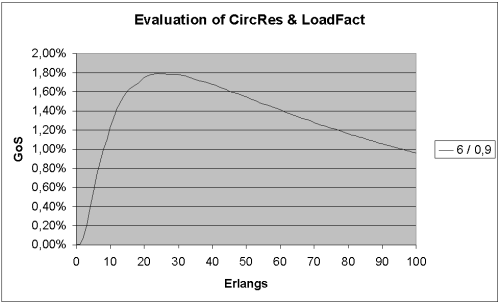
Evaluation of reserved circuits for VoD service
3 Residential market
3.1 Introduction
The residential broadband access market is growing quickly, with DSL and fiber operators
dominating the market. We consider providing the modeled services via ADSL or Gigabit
Ethernet network architectures.
The Residential Market view is shown below, showing the market segment, the offered
services and all the resources. Resources can be split into two categories: connection-driven
and traffic-driven. For instance, a connection-driven resource could be a modem
(a modem will be necessary for every customer). On the other hand, STM1, STM4 and
Gigabit Ethernet links will be driven by the bandwidth required and so will be traffic-driven.
In the following paragraphs, we analyze in detail the definition of the market segment,
of the services and of the resources, defining the inputs and showing some of the
outputs we can obtain from the model.
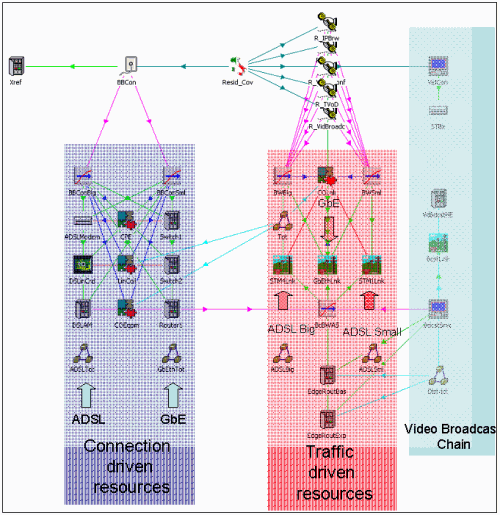
Residential market model
Market segment (potential market)
We consider as the potential residential market every home in Italy. Each residential
user is connected to the nearest Central Office, with an ADSL connection, or with
a Gigabit Ethernet connection.
Deployment (covered market)
As Deployment we assume to have a central office in each municipality equipped with
a DSLAM or with a Router, h aving ADSL or fiber connections respectively. From the
ISTAT database we have the list of the 8101 Italian municipalities with the associated
number of homes for each. The 21 million families are our potential market, but
to reach them we must install a DSLAM base rack or a Router in their Central Office,
converting those subscribers from potential to reachable (or covered) subscribers.
At this point, we have chosen our strategy to make our business more attractive:
start installing the bigger Central Offices first and then continue with the smaller
COs. This means that we can sort our database by descending number of families,
so creating a relationship between numbers of COs equipped with a DSLAM or a Router
and the relevant covered population. This function looks like the following graph
(UA) and we can describe it through a 10-segment linear interpolation (UAx) passing
through properly chosen points. Big COs are defined as those having more than 40
000 families.
In addition, we will call Lb the number of Home Lines corresponding to the Big areas
above. The input to STEM for the UAx function is:
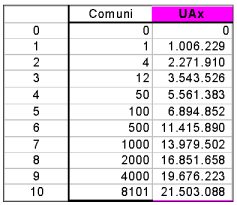
Input STEM for the UAx Function
From these 10 segments we may derive a reasonably good evaluation of the population
covered when a give number of COs have been equipped with a basic DSLAM or with
a Router in ADSL or Gigabit Ethernet configuration respectively.
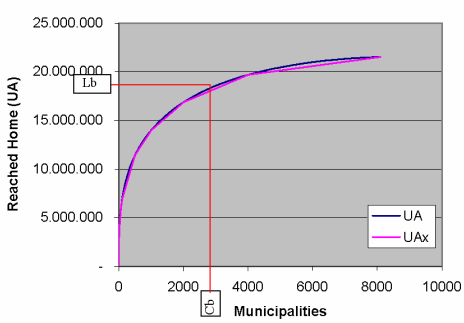
Reached homes/Municipalities
3.2 Network architectures
The availability of broadband access networks may be a serious problem from the
point of view of providing these services. Present technologies make it possible
to realize a transport network of high capacity with limited investments, while
the realization of low-cost access networks is quite hard. In the following paragraph
we will analyze the ADSL and Fiber access architectures, giving special attention
to such problems and introducing the architecture considered within the model.
ADSL architecture
ADSL technology has been designed to provide services to residential or small business
customers and to allow the use of a copper wire to carry both data and traditional
voice. The technology is asymmetrical because the bandwidth dedicated to the down-link
(from the network to the subscriber) is usually greater than the bandwidth dedicated
to the up-link (from the subscribers to the network). Such differentiation has been
created thinking to the send multimedia content to the users, while offering a convenient
bandwidth also to support the interactivity with the net. The bandwidth, depending
on the length and type of the twisted-pair copper wire, can reach 8Mbit/s for the
down-link and 1Mbit/s for the up-link. The applications more suitable for ADSL technology
are Internet browsing, VoD, Video broadcasting and remote access to local area networks
(LANs), typical characteristics of residential or SOHO users. The reduced up-link
bandwidth makes this solution not suitable for the large-enterprise market, which
needs LAN-to-LAN connection.
ADSL is currently offered in Italy in various packages: the most economic offers
provide an access speed of 128-256kbit/s upstream. Some operators offer 4-6Mbit/s
downstream and 512-640kbit/s upstream, using a single duplex cable in unbundling.
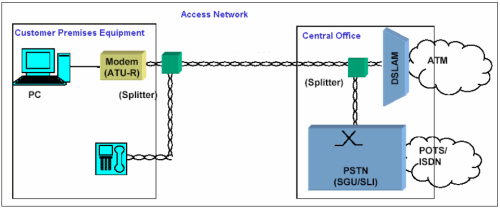
ADSL access network
A DSLAM can concentrate a considerable number of modems. It multiplexes thousands
of accesses in a high-density interface with the transport network. In this way
is possible to concentrate the required bandwidth into a few backhaul connections
(1 to 4 STM1s or STM4s). In the most common solutions, the multiplexing is based
on ATM cells. The presence of DSLAM implies, therefore, the presence of an ATM network
for the concentration.
The customer equipment is generally an ATU-R (ADSL Termination Unit – Remote) or
ADSL Modem, used to connect a single computer (interface USB or Ethernet), or integrated
with a router, to allow a LAN access. A filter (splitter) in the Central Office
combines the digital signal with the traditional telephone signal. A second splitter
is necessary on the customer site to send the signal toward the telephone devices
or towards the digital devices. These filters can be removed if the telephone service
does not have to be provided, or if it is directly integrated in the data stream
(by means of Voice-over-ADSL or Voice-over-IP).
The necessity of a splitter represents a significant increase of costs because it
requires installation in the customer’s house. The problem has been solved replacing
the splitter with a microfilter which can be plugged into the telephone outlet by
the customer himself. Technological improvements in microfilters now allow them
to reach the same bit rate as with a splitter.
ADSL is quickly reaching maturity. The increase of the density of DSLAM line cards
in DSLAMs and the fall in the cost of modems has notably reduced equipment costs
and has contributed to the reduction of the general costs and, consequently, of
the market prices.
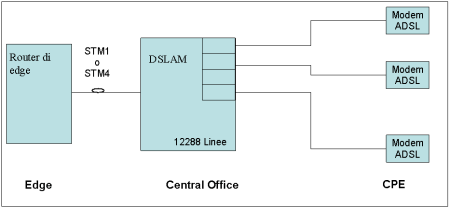
ADSL Network architecture
The following table shows the technical equipment specification considered within
the ADSL model.
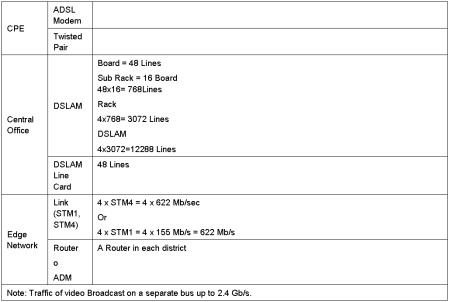
ADSL Resource specification
Optical fiber architecture
Telecoms systems based on optical fiber today represent the best possible solution
for access networks from the point of view of bandwidth and reliability. Optical
fiber is largely used for providing access to large enterprises, whose spend on
telecoms services justifies the investment. It is also used more and more to provide
access to residential customers, due to the increasing penetration of new broadband
services.
The roll-out of a fiber network can follow two strategies: the direct realization
of an access network in fiber-to-the-home, or the gradual diffusion of fiber from
the core network to local offices where copper to the customer can be used. Radio
technology can replace the copper links in some cases. Two basic architectures for
the implementation of optical fiber in the access network are shown below.
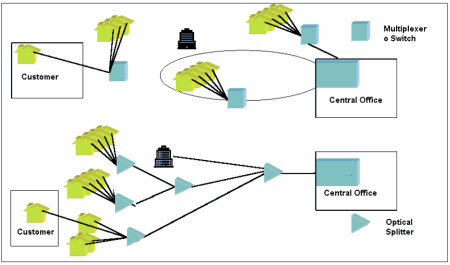
Optical fiber architecture
The upper scheme shows a ring configuration with remote equipment near the user
sites. This architecture allows the fiber ring to be shared among many customers,
making also the system adaptable to the residential user. With SDH transmission
technology, which is usually realized in ring configurations, the bandwidth to the
user can range from 2Mbit/s up to 10Gbit/s. The bandwidth given to a single customer
is dedicated to the first switching node. On the customer side, a multiplexer combines
the different data flows in an unique SDH flow. Besides the SDH technique, another
access technique is used in ring configurations, namely Ethernet (or Gigabit Ethernet).
In this case the multiplexers present in the SDH infrastructure are replaced by
an Ethernet switch, making it possible to dynamically share the available bandwidth
on the ring among the active users according to need, and not based on time as am
SDH cross-connector would do.
The lower scheme shows a tree configuration point-to-multipoint). The best-known
technique of this type is Passive Optical Network, whose advantage is due to the
fact that the optical splitters are completely passive and do not require a power
supply or air conditioning. Passive technology limits, however, the maximum distance
between the plant and the optical termination to 20km and the number of terminations
to 32. The typical bandwidth of this system is 622Mbit/s downstream and 155Mbit/s
upstream. Bandwidth can be increased by using WDM multiplexing techniques: by introducing
remote multiplexers the number of customers can be expanded to over 32. The transmission
standard on this type of infrastructure is either ATM or Ethernet; in this case,
we speak of APON nets (ATM over PON) or EPON (Ethernet over PON), respectively.
Such a configuration is particularly suitable as a substitute for the copper access
network, and in fact physically follows the same architecture; however, it does
not offer the same advantages as a ring configuration in terms of redundancies.
The implementation of this solution is limited by the large investment required.
Replacing the twisted-pair with an optical loop can only start from urban and business
areas where the scales of economy can justify the investments. The main problem
for operators who want to renew the access network comes from the high cost of digging
and the duct infrastructure, and from bureaucratic delays in permission to proceed.
Gigabit Ethernet architecture
The figure below shows the optical fiber architecture considered within the model.
An initial investment is required in order to deploy sufficient resources to effect
coverage of the territory. The investments that follow will be made through the
revenues gained from the first clients taking the service.
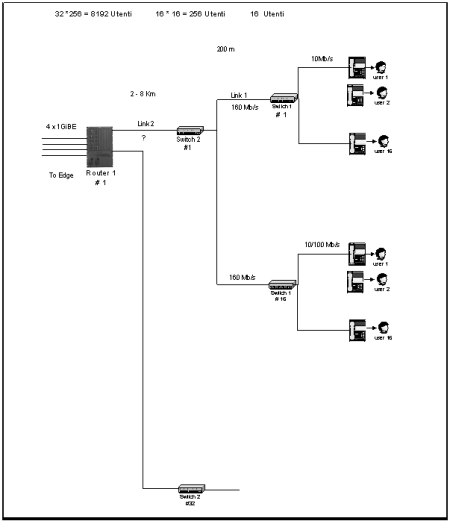
Gigabit Ethernet Network architecture
The project considers:
(a) Initial investment:
- An optical fiber ring that covers the whole city.
- Routers placed in proximity of the CO of Telecom Italia that would be the equivalent,
in terms of coverage, to a DSLAM.
(b) Peripheral part: two levels of switch that cover 256 (16 * 16) customers:
- Switch 1: 16 users.
- Switch 2: 16 switch 1
A router could cover 32 switches: 256 * 32 = 8192 users.
Our strategy does not immediately install all the switches, but we have assumed
that coverage is achieved when one single Router (Router 1) has been installed in
the same Central Office that is equivalent to the DSLAM sites.
The model assumes the following strategy for non-dominant operators providing a
start-up configuration in their planned areas:
(a) We implement the geographical coverage
(b)If a customer asks for the service, two strategies can be applied:
- If he is in a covered area, we simply expand the equipment by providing a subscriber’s
line card.
- If he is not in our covered areas, we can offer the services using the ADSL Wholesale
offer of the dominant operator (this case is not included in the model).
The Edge link could be made either with four Gigabit Ethernet fibers or with a ring
SDH (STM16) with ADM and only one fiber. This will depend on the ownership of the
fiber. In fact, different operators have different costs for access to installed
fibers. Fastweb, for instance, has access to dark fiber at costs which are less
than the cost of the high-hierarchy ADM interfaces.
In our model, the cost of link 1 will be included in the cost of switch 1 while
that of link 2 will be included in switch 2.
3.3 Output analysis: IP replacing DSL
Within the model, two alternative technologies are considered to provide the modeled
services to the residential market segment: ADSL and Gigabit Ethernet.
Note: In this extract from the report, details of the services and resources modeled
are not provided. For more information, please contact CEFRIEL.
A distinction was made between Big Central Offices and Small Central Offices for
both technologies. Big COs are those installed in the more populated municipalities
and small COs are the others. Having chosen a "big-to-small" deployment strategy,
Big COs will first be installed in the first "CObThreshold" municipalities. Having
defined as "Big" those COs having more than 40 000 subscribers, we have found 67
Big sites; the remainder are classified as Small.
An input will be the total number of COs (COtt) from which the total number of Big
COs (COtb) can be calculated as follows:
COtb=min (COtt; CObThreshold)
The remaining COs will be Small, so the total number of Small COs (COts) is:
COts = max (0; Tot.COtt - Big.COtb)
The meaning of this formula is that, during the deployment, if we have installed
less than CObThreshold COs, this means that we are still installing Big offices,
otherwise, we are installing small ones.
Other input parameters will be Pab and Pas representing the proportion of Big and
Small COs installed in each year using ADSL technology.
Starting from these input data, we may complete the following table. New installations
are driven by Pab and Pas, whereas reductions are applied according to the proportion
of Big or Small COs at the end of the previous year.
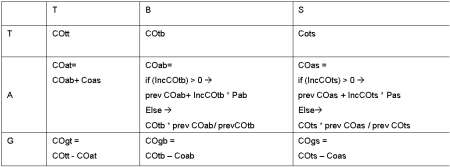
Central Offices Calculation (Big / Small, ADSL / Gigabit Ethernet)
In the following example (whose input data are shown in the figure below) we have
stated to install the ADSL technology according to the proportion of Big and Small
COs defined by the parameters Pab and Pas. The model output relates to the installation
of Router and Gigabit Ethernet Links (in the Gigabit Ethernet case) and of DSLAM
and STMx Links (in the ADSL case). This output is shown in the lower part of the
figure and represented graphically in the following charts.
We may note that at the beginning of Y4 we stop rolling out ADSL technology in favor
of Gigabit Ethernet, resetting at year Y4 the proportions of new ADSL installations
(Pab=Pas=0).

Technology switch-over data (input and output)
Consequently, beginning from the Y4 the model does not install new ADSL resources,
while the existing areas are held till to their end of life (equipment lifetime).
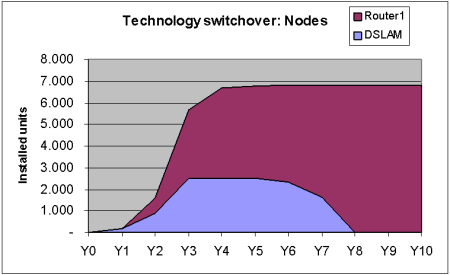
Technology switch-over: Nodes
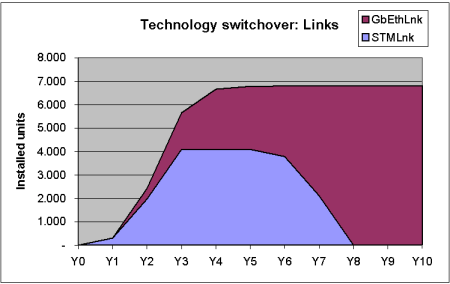
Technology switch-over: Links
4 Nomadic
4.1 Introduction
The commercial success of the Wi-Fi (802.11b) standard has accelerated the growth
of the WLAN market, and expanded its potential into new application areas and vertical
markets. Todays WLAN market is multi-faceted and incorporates a very wide range
of sectors and applications. The initial focus on the corporate sector still remains,
but it has spawned three other major growth areas: ‘last mile’ broadband access,
public hotspots and home networking. In three or four years’ time many of the competing
networking technologies of today will be integrated into access points and devices
to enable seamless connections between different technologies.
The nomadic user will increasingly have the opportunity to access the Internet through
wireless means whilst out of the office or away from home. They will need an access
device that is capable of wireless connectivity to an appropriate network. This
may be through a mobile-phone-based device, a PDA or a computer notebook. Increasingly
over the next five years, these three separate forms of mobile device will begin
to merge and become increasingly similar in functionality and form, although there
will always be a market for low- and high-end devices, as well as devices offering
particular strengths and specialist options.
Commercial Wi-Fi Hotspots
Wireless Internet Service Providers (WISPs) are rapidly deploying networks in the
Public Space or Public Hotspot sector. Currently only laptops or notebooks and some
PDAs can be upgraded with a WLAN card, or are sold with an in-built WLAN capability.
In addition, it is felt that some mobile telephones will be able to connect to these
hotspots via their Bluetooth capability, or through a WLAN capability.
Examples of hotspots include hotel lobbies, coffee shops, convention centers, petrol
stations and airports. A number of international restaurants, etc. have announced
partnerships with Wireless ISPS, but a word of caution is necessary when estimating
the size of this sector. The deployment figures for many locations include more
than one hotspot. Airports for instance will have different hotspots operating in
each of the main airline lounges and terminals, while hotels may have hotspots covering
the business centre, meeting rooms, restaurant/bars, and leisure areas.
Last-mile WLAN
In addition to hotspot provision, WISPs are using WLAN technologies to provide last-mile
broadband access. This unconventional application for WLANs is difficult for many
inside and outside the industry to accept. WLAN has previously been neatly pigeon-holed
into the traditional role of a fixed-wire LAN replacement technology, and applications
outside this use have been viewed with suspicion by some. However, a large number
of enterprising ISPs have shown that WLANs can be very flexible, and can be used
to provide robust services. Small WISPs now number in the thousands, offering ‘free’
community connections, or full commercial services to businesses and residential
customers. Despite potential market inhibitors like radio interference and line-of-sight
limitations, some industry commentators believe that the sector has a significant
growth potential. The use of 802.11a (5GHz) and the 802.16 standard will play an
important part in this sector.
The fundamentals of WLAN technology make it a good last-mile access solution for
small ISPs who wish to provide broadband access without investing large amounts
of capital in infrastructure. This makes it an ideal solution for rural locations
and developing economies, where a digital fixed infrastructure is not widely available.
In this report, we have provided ten-year forecasts for the increase in the number
of hotspots and their users.
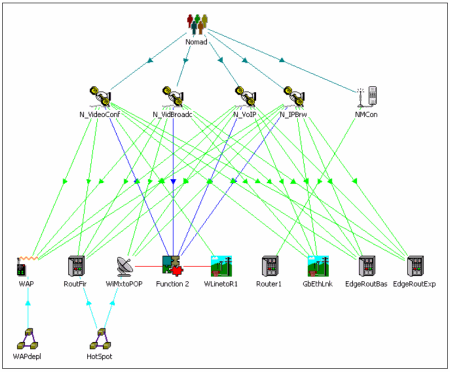
Nomadic Market Model
4.2 Network architecture
The figure below shows the architecture for Nomadic access considered within the
model.
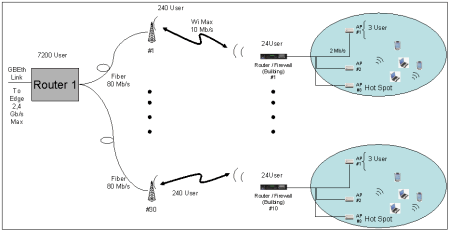
Nomadic network architecture

Nomadic network hypothesis
4.3 Output analysis: WiMax vs Full Fiber
An interesting outcome of our model is a cost-comparison of the implementation of
two solutions that are currently under a lot of debate:
- A mix of WiMax for last mile, connected through a fiber ring.
- Same fiber rings connecting optical multiplexers for last-mile fibers.
We proceed, therefore, to compare the operating charges, as we have a mix of investment
and rental rates. In the first solution, we consider amortization and maintenance
for WiMax and rental for fiber, whereas we have only rental in the full-fiber case.

WiMax architecture
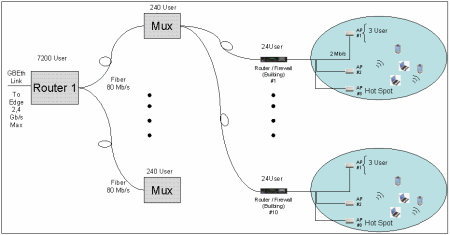
Full fiber architecture
In order to make the comparison, we assumed an installation of the two solutions
using the same proportion (WiMax Prop=0.5), as shown below. Under these conditions
the installed capacity of WiMax and Fiber links are the same. In spite of the same
installed capacity, we may note that the operating charge is much less for the WiMax
solution.

Technology mix: WiMax vs Full fiber (input data)
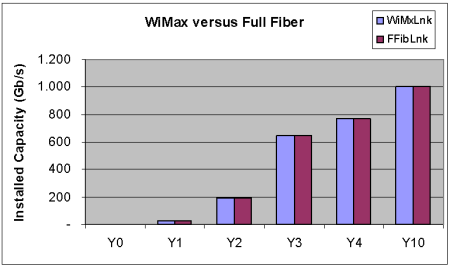
Technology mix: WiMax vs Full fiber (installed capacity)
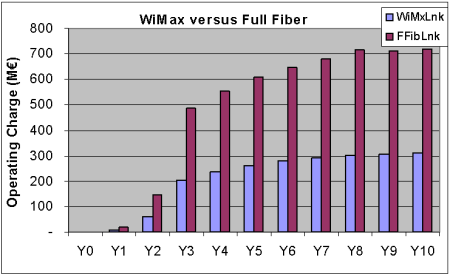
Technology mix: WiMax vs Full fiber (operating charge)
5 Mobile
UMTS has been attracting considerable attention, partly due to its high revenue
potential and partly due to the uncertainties that it holds in terms of both business
and technology.
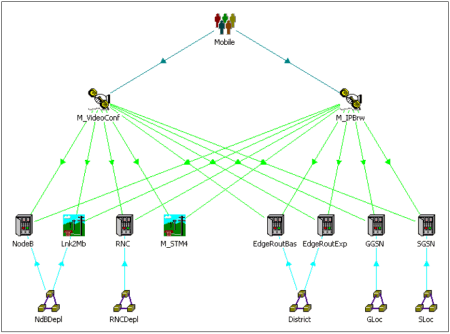
Mobile market model
As shown in the figure below, it is possible to identify three independent parts
within the UMTS R99 network:
- The Mobile Station MS (mobile equipment) that could be third- or second-generation.
- The access radio networks UTRAN, composed from different RNSs (Radio Network Sub-Systems).
Every RNS is composed from different Node Bs that control a group of cells with
different access technologies. These Node Bs are controlled by a unit called the
Radio Network Controller (RNC). All these components are called Radio Network Subsystems
(RNS), which has the fundamental function of connecting the mobile world with the
core network through the Uu (radio interface) and the Iu, and managing the handover
procedures.
- The Core Network (CN) is composed of a circuit-switching structure, compatible with
2G, and by a packet-switching structure that is an update of the GPRS backbone.
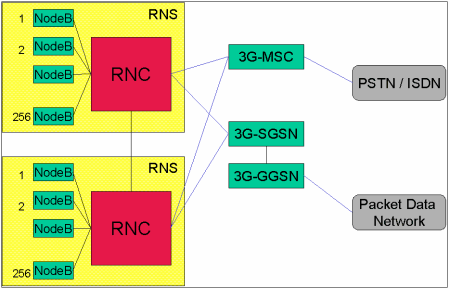
UMTS network architecture
Analyzing the 2G network characteristics and the GPRS system, it is easy to understand
that the first network will maintain the characteristics of the two types of backbone.
It is reasonable to think that the circuit structure of the GSM network is used
to support the actual subscribers and to furnish the voice service of the UMTS.
The IP network, characteristic of the packet-switching GPRS network, will serve
instead to furnish IP multimedia services.
The chart below show the total Operating Charge for each resource. It represents
the sum of Depreciation and Amortization and Operating Costs. The ‘Other’ category
of Operating Charges is broken down further in the following chart.
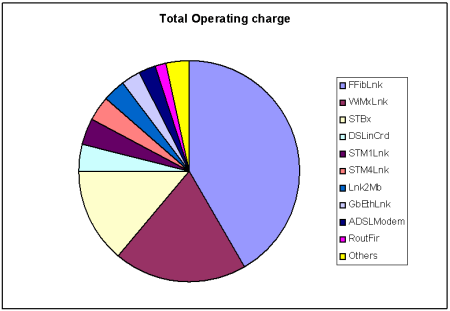
Total operating charge
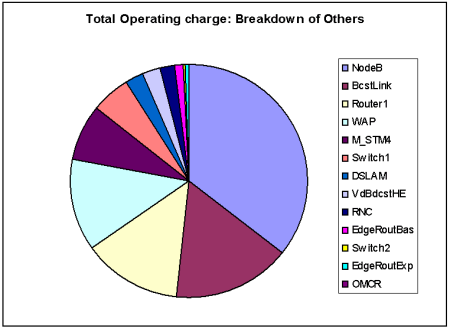
Total operating charge: breakdown of ‘Other’ charges
CEFRIEL is the ICT Centre of
Excellence For Research, Innovation, Education & industrial Labs partnership
of Politecnico di Milano. It aims at boosting the technology and expertise transfer
between public and local government, industry and academia in the dynamic ICT field.
Alcatel provides end-to-end
communications solutions, enabling carriers, service providers and enterprises to
deliver content to any type of user, anywhere in the world.